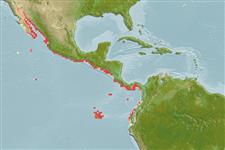>
Holocentriformes (Squirrelfishes, soldierfishes) >
Holocentridae (Squirrelfishes, soldierfishes) > Myripristinae
Etymology: Myripristis: Greek, myros, -ou = male of morey eel + Greek, pristis = saw (Ref. 45335).
More on author: Valenciennes.
Environment: milieu / climate zone / depth range / distribution range
Ecología
marino asociado a arrecife; rango de profundidad 3 - 24 m (Ref. 5227). Tropical; 32°N - 1°S
Eastern Pacific: Gulf of California to Ecuador, including the Galapagos Islands. Also found in the Revillagigedo and Cocos islands (Ref. 36626).
Tamaño / Peso / Age
Maturity: Lm ? range ? - ? cm
Max length : 18.0 cm TL macho / no sexado; (Ref. 55763); common length : 12.0 cm TL macho / no sexado; (Ref. 55763)
Short description
Claves de identificación | Morfología | Morfometría
Espinas dorsales (total) : 11; Radios blandos dorsales (total) : 12 - 15; Espinas anales: 4; Radios blandos anales: 11 - 13; Vértebra: 26. Branchiostegal rays: 8-8 (Ref. 36626).
Adults hide under conspicuous rocks and small caves during the day. Form small groups on rocky and occasionally soft substrates or near the surface at night. Feed principally on crustaceans. Oviparous, with planktonic larvae (Ref. 36626). Appear occasionally in markets and marketed fresh.
Life cycle and mating behavior
Madurez | Reproducción | Puesta | Huevos | Fecundidad | Larva
Oviparous (Ref. 36626). Also Ref. 240.
Schneider, W. and F. Krupp, 1995. Holocentridae. Candiles. p. 1182-1185. In W. Fischer, F. Krupp, W. Schneider, C. Sommer, K.E. Carpenter and V. Niem (eds.) Guia FAO para Identification de Especies para lo Fines de la Pesca. Pacifico Centro-Oriental. 3 Vols. FAO, Rome. (Ref. 9307)
IUCN Red List Status (Ref. 130435: Version 2024-1)
Threat to humans
Harmless
Human uses
Pesquerías: escaso valor comercial
Herramientas
Special reports
Download XML
Fuentes de Internet
Estimates based on models
Preferred temperature (Ref.
123201): 22.4 - 29.1, mean 26.7 °C (based on 225 cells).
Phylogenetic diversity index (Ref.
82804): PD
50 = 0.5000 [Uniqueness, from 0.5 = low to 2.0 = high].
Bayesian length-weight: a=0.01950 (0.01084 - 0.03506), b=3.13 (2.98 - 3.28), in cm total length, based on LWR estimates for this species & Genus-body shape (Ref.
93245).
Nivel trófico (Ref.
69278): 3.1 ±0.30 se; based on food items.
Resiliencia (Ref.
120179): Alto, población duplicada en un tiempo mínimo inferior a 15 meses (Preliminary K or Fecundity.).
Fishing Vulnerability (Ref.
59153): Low vulnerability (10 of 100).
Nutrients (Ref.
124155): Calcium = 86.6 [41.8, 270.8] mg/100g; Iron = 0.931 [0.402, 1.955] mg/100g; Protein = 18.2 [17.0, 19.4] %; Omega3 = 0.148 [0.060, 0.350] g/100g; Selenium = 29.6 [17.0, 57.1] μg/100g; VitaminA = 111 [42, 297] μg/100g; Zinc = 1.62 [1.04, 2.52] mg/100g (wet weight);
